

Indiana Nursery & Landscape News
UPCOMING EVENTS
November
11 or 12 TBD Contractors on TAP, Fort Wayne, IN area
12
19-20
December
9-10
Please keep a lookout for event details as they are being finalized
Lunch and Learn Series (Free), Barringer's Tavern, 2535 S Meridian St., Indianapolis, IN 46225 bit.ly/iaalunchandlearn
MRTF Landscape & Turf Seminar, W. H. Daniel Turfgrass and Research Center, 1340 Cherry Lane, West Lafayette, IN 47907 www.mrtf.org
INCFC Symposium, Switchyard Pavilion, Bloomington, IN 47403 events.humanitix.com/indiana-community-and-urban-forestry-symposium
12 ILA Holiday Celebration Annual Meeting, Action and Atomic Duckpin Bowling, Indianapolis, IN 46203 www.indylandscape.com
17
February 2026
9-11
July 2026
Winter Tree ID, Crown Hill Cemetery, Indianapolis, IN 46203 events.humanitix.com/winter-tree-id-workshop-at-crown-hill-cemetery
Indiana Green Expo, Indianapolis Convention Center, 100 S Capitol Ave., Indianapolis, IN 46225 Large Exhibitor Move-In (ONLY) www.indianagreenexpo.com
18 IOMA Golf Fundraiser, Twin Lakes Golf Club, 3200 West 96th St., Caramel, IN 46032
21 Summer Purdue Turf and Landscape Field Day, Daniel Turf Center, 1340 Cherry Ln., West Lafayette, IN 47097
Visit http://inla.org/events-calendar/ for updates and new event listings.
New Initial IAH
James Bauer, NCCF, New Castle, IN
TRANSFORMING INNOVATION, INTO INSPIRATION
As a leader in the hardscape industry, Unilock delivers cutting-edge solutions that drive unmatched efficiency. Whether it’s the labor-saving UniLyft or our groundbreaking U-Cara® Modular System, we empower you to achieve exceptional results with every project.



CONTACT YOUR LOCAL TERRITORY MANAGER



EXECUTIVE DIRECTOR'S LETTER

Hello, all Indiana sports fans. I have just a few words to say whether you are an over-the-top fanatic or not of sports, it appears that the state of Indiana has plenty to be proud of. From the football Indianapolis Colts to the football Indiana Hoosiers, currently undefeated as of this writing (October 9, 2025), in preparation for the upcoming November/December 2025 of the INLN magazine. The Pacers made a great run in the NBA Finals, and the Indiana Fever almost made it to the WNBA Finals, even without several of their key players. But then again Indiana has always been known for its basketball prowess, whether it be a wide variety of high schools, colleges (Purdue, Indiana, Notre Dame, Vincennes (Junior College) etc. Well, I guess it is better to reach out to more within the confines of the green industry.
I personally am grateful to have had a passion (hobby), that grew into a rewarding career in this profession! I am going to briefly mention some of the upcoming events that the INLA is going to be a part of, or hosting. In this edition of the INLN, some of these events such as the Indiana Green Expo will be a totally separate article with limited information that will be forthcoming in emails, website updates, and other pertinent
information directly. The www.indianagreenexpo.com website currently has the 2026-exhibitor contract for vendors, with booth pricing, sponsorships, advertising which will be held in February at Indiana Convention Center. The dates are
February 8-11, 2026. The exhibitors with larger displays of 20’X20’ or larger will have the option, much like last year of a Sunday movein, with others coming in for final setup on Monday, February 9, 2026. The Monday date could be a little cumbersome with others wanting to move in smaller booths. However, we will have forklifts available on both days for a limited time, and these are complimentary of the India Green Expo. So, if any of INLA Members have a particular vendor that feel could be an asset to the IGE, please share this information. I know many companies offer incentives to the referring company in the way of discounts or other opportunities regarding the products they sell. Our host hotel is The Westin which our block of rooms completely sold out early! You can simply park your vehicle at either the hotel or one of the other local parking garages and use the Skywalk from the hotel straight to the convention center.
Also, I cannot stress enough to all companies, having their vested staff in the field that can register for updated Indiana Department of Natural Resources, on the page titled INLA Member Resources. Especially those working with the public sector, whether it be landscaping sector, either residential or commercial, garden centers and private clients raise awareness to them beforehand, regarding a certain pest or disease that found its
way into Indiana. Sounds to me like an easy way to make an enhanced sell to those that want to keep their home improvement projects safe by increasing the longevity of their purchases.
In this edition, and on the INLA Website register for the 2025 INLA Green Excellence Award details for registering projects with a registration date to be submitted by December 15, 2025. I have heard from many companies that are planning to submit for different categories this year, so never hesitate to get an early start planning for your submission of projects. Please remember also the before, during and after pictures will help the judges hear the story behind the project’s pictures.
Upon closing this edition of my Executive Director letter, I wish to extend a personal note of gratitude and a heartfelt Thank you to all the volunteers and board members that have assisted in the success of our association. It just goes to prove it takes a small army of volunteers that is required to make these events as successful as they have been. I also included a new tagline, I saw at a recent conference before ending this scintillating document.
It is better to have done something, than being somebody,
Rick Haggard –Executive Director
Rick Haggard
See what the INLA is all about!
Follow us on social media to be the first to learn about upcoming events, see your colleagues' businesses, and get featured yourself.


PRESIDENT SHAUN YEARY'S MESSAGE
To our INLA Members,
I think I speak for everyone here, Thank God it’s Fall. Holy guacamole that was one heck of a hot sticky Summer. In my new role, my work is never not busy. Double negative, I know. Who would have thought that the most wildest, craziest seed and fertilizer selling time would be in October? I guess I do now. I’ve been in this Industry 26 years now, but never very strong on the maintenance side of things. However, I did have my 3b applicators license at one point even though I somehow managed to burn up and TigerStripe Frank’s fairly new lawn up in Noblesville several years ago. He loves to tell that story. In my defense, it had been a minute, and I was a little rusty. It was pretty sunny though. Maybe the glare did it? Either way, it seems that a lot of us vendors are having some sort of agronomy Bonanza.
Whats going on in the INLA?
Last month we had the great privilege of attending the annual Great Lakes Leadership Conference. It’s a conference that consists of 9 different Landscape Associations whose Executive Teams get together once a year to compare notes and share ideas. It’s a conference that is hosted by a different region each year. This year we were hosted by Landscape Ontario just north of Niagara and toured their amazing newly renovated facility. Now we’re back with a lot of ideas as to how we can improve our Association and our members experience. My absolutely favorite part of this process was the journey. Rick Haggard, our Executive Director,
and I rode up to Ft. Wayne where we me up with our President-Elect, Kevin Van Sessen. From there we drove the rest of the way to Niagara where we hopped on a boat and got a super close-up experience of one of Mother Nature’s most amazing features. All of those hours of windshield time allowed us to share our thoughts on the Association and life in general. It was a great bonding experience and we’re all closer and more aligned than ever.
We recently restructured some of our committees by combining a couple of them into a larger one in effort to improve communication processes and how we operate as a Board. Let me introduce myself as the new, Operations Committee Chair. I’ll be working together with Kevin Van Sessen in developing our Indiana Green Expo Trade Show and our annual Summer Meeting. We just had our first meeting in this capacity, and I feel very positive about the direction we’re moving in. Looks like the IGE Trade Show will be remaining in Hall D this coming February and we’re ready for it. Our committee is a well-oiled machine and ready to take on the challenge. Our media team at JRL are also ready to come out in full force with goal of helping us better communicate the value of what our show has to offer.
I want to give a special thanks to our whole team working behind the scenes to keep our Association moving. The people we contract with, our committee members, our Board, our Executive Board and our Executive Director. I’m grateful for all your contributions and the bonds
we’ve been able to create, in many cases, are destined to be lifelong friendships. Our Executive Team is as strong as it’s ever been and I’m excited to move forward with all of you.
This Article's Book Recommendation
The Obstacle is the Way
The Timeless Art of Turning Trials into Triumph
By Ryan Holiday Best wishes, Shaun




We are a recruiting agency specializing in seasonal to permanent staffing services for U.S. companies.

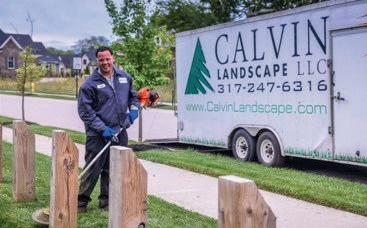
Amigos Recruiting has developed a program to provide additional sources of reliable labor. We have established recruiting networks within Spanish speaking communities in different parts of the United States and its Commonwealths that experience higher rates of unemployment than the rest of the country. For a


A retiree’s guide for National Retirement Security Month
If you’re retired, it’s easy to let your finances go on autopilot. Since October is National Retirement Security Month, it’s a good time to revisit some areas that can impact your long-term financial security and help your money last a lifetime.
Consider these suggestions:
• Manage your withdrawal rate. You’ll likely need to tap into your retirement accounts — your IRA and 401(k) or similar employer-sponsored plan. But think carefully about how much income you withdraw every year. If you take out too much, especially in the early years of your retirement, you risk outliving your resources. You have the option of withdrawing from these accounts at age 59½. Once you turn 73, you’ll be required to take out at least a certain amount each year based on your age and account balance.
• Estimate health care costs. When you turn 65, you will be eligible for Medicare, but you may still need a Medicare supplement plan, both of which will require premium payments. You’ll probably also incur a variety of other unreimbursed expenses for doctor visit copays or deductibles, prescription drugs and vision, hearing and dental care. Additionally, about 70% of adults ages 65 and older will need some form of long-term support, according to the Department of Health and Human Services. This may include a paid home health aide (average cost of $77,792 per year), an assisted living residence (average cost of $70,500 per year) or nursing home care (private room average cost of $127,750 per year). (Cost estimates are from Genworth 2024 Cost of Care Survey.) Over the course of your retirement, these can add up, so be realistic when budgeting for health care expenses in retirement.
• Consider when to take Social Security. You can start receiving monthly Social Security checks at age 62, but your payments will generally be larger if you wait until your “full” retirement age of 66 or 67. (The size of your payments will “max out” at age 70.) If you believe you have longevity working in your favor, and you can afford to wait, you may well be better off by delaying Social Security as long as possible.
• Avoid investing too conservatively. Once you’re retired, you might think you should take as few chances with your investments as possible — after all, you have less time for them to bounce back from a downturn than you did during your working years. Nonetheless, it’s important to consider keeping a reasonable percentage of growth-oriented investments in your portfolio to help you stay ahead of inflation. Even at a low rate, inflation can erode your purchasing power over time.
• Keep your generosity in check. If you have grown children who need financial help, or grandchildren heading to college someday, you’d no doubt like to do what you can to assist them. However, the hard truth is that they have more time than you to find workable financial solutions, whereas if you deplete your funds through your generosity, you could put yourself in a precarious position. So, be as giving as you can afford — but try not to go beyond that. By preserving your financial independence, you’ll end up benefiting your family as well.
Retirement is ideally an enjoyable time in your life, especially if you feel financially stable. So, take time to check in periodically to keep that stability on track.
This article was written by Edward Jones for use by your local Edward Jones Financial Advisor. Edward Jones, Member SIPC

` Michael Mann Financial Advisor
Edward Jones
2159 Glebe St. Suite 150 Carmel, IN 46032
317 571-0522

The Truth About Online Payments: What to Watch For and How to Make Them Work for You
By Ashley Marino, Service First Processing (SFP)
This document discusses the importance of online payment gateways for businesses in the green industry, highlighting benefits, risks, and protective measures.
Benefits of Online Gateways
· Online payment gateways enhance efficiency by enabling quick, secure invoicing and payment processing.
· They offer flexibility with one-time or recurring billing options and provide real-time reporting, reducing manual errors and the need for check chasing.
· A knowledgeable payment processor can optimize these tools to minimize costs and complexity.
Fraud Risks and Consequences
· Increased convenience from online payments also raises fraud risks, particularly in the green industry with high-value transactions.
· Fraud can lead to chargebacks, frozen funds, reputational damage, higher processing fees, and compliance fines.
· Common fraud types include stolen card transactions, chargeback abuse, business email compromise, phishing scams, account takeovers, and refund scams.
Protection Strategies
· Implementing a secure payment system involves using tools like Address Verification (AVS), Card Verification (CVV), IP monitoring, velocity filters, and tokenization to safeguard transactions and customer data.
· Hidden Costs and Fee Traps
· Businesses may encounter unexpected charges such as platform fees, non-qualified processing rates, and unlisted monthly fees, which can erode profit margins, especially during peak transaction periods.
Conclusion
· A reliable payment processor should act as a strategic partner, offering comprehensive fraud protection, transparent pricing, tailored solutions, and dedicated support to safeguard revenue and reputation.

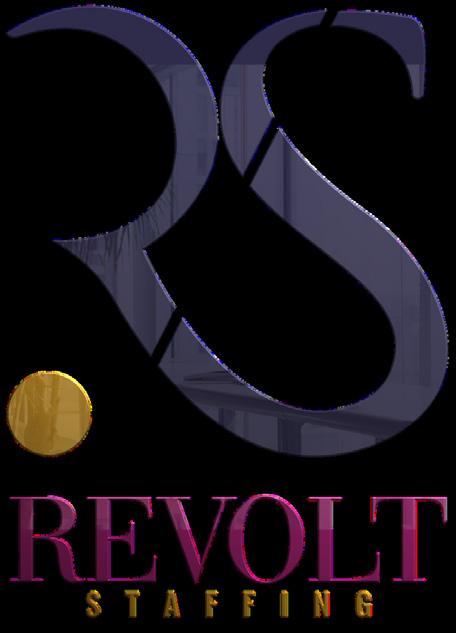



INDIANA GREEN EXPO 2026 UPDATE
By Rick Haggard – INLA Executive Director
To all that have attended or considered attending the Indiana Green Expo (IGE), please do not make the mistake of possibly not attending the 2026 IGE. The dates are February 9-11, 2026, at the Indiana Convention Center in downtown Indianapolis, Indiana. Educational Days are February 9, 2026, for advanced course education as well as a review and testing for the Indiana Accredited Horticulturist (IAH) certification. Further details will be forthcoming, if not already listed upon on arrival of this edition of the Indiana Nursery and Landscape Newsletter. February 10-11, 2026 will serve as both educational as well as a trade-show event. The education classes will have several much-needed licensed applicators CCH Certification classes as well as IAH CEU Certification classes. The Tradeshow will host a varying number of products, including some new items that have either been released either in 2025 or coming out in 2026. These will primarily be in the “New Product Showcase” designated are or be identified in the exhibitors’ booths.
If anyone has a particular vendor or a vendor that has an exceptional product, please advise them to checkout the IGE Website; www.indianagreenexpo.com and look at the “2026 Exhibit Booth Information”. The 2025 Indiana Green Expo was pretty much a sell-out of exhibit booths, plus with over 1400 attendees, with roughly 200 Exhibit booth personnel.
The following companies have either committed verbally or made a downpayment on their booth for 2026.
Alphabetical order only:
Abrams Nursery
Advanced Turf Solutions
Ameri-Turf
Bowling Nursery
Elevate Landscape & Architecture Design
Forrest Keling Nursery
Greenleaf Nursery Company
Harrell’s LLC
Heritage Landscape Supply Group
Hortica, a brand of the Sentry Insurance Group
J. Frank Schmidt & Son Co
John Platte Nursery Sales dba Perennials Plus
Kenney Machinery
McGavic Outdoor Power Supply
Millcreek Gardens
ProGreen Synthetic Turf
Russo Power Equipment
Stantec Native Plant Nursery
The Cisco Companies – Cisco Seeds
Walters Gardens
Acorn Farms
American BioChar Company
Blue Grass Farms of Indiana
Brickworks Supply Center
Estes Material Sales
Genesis Sod Farm
Green Stone LLC
Home Nursery
Hortech, INC
Indiana DNR
Jackson’s Nursery INC
Kankakee Nursery Co
Links Aerification
Mid-State Truck Equipment
Northland Farms
Proven Winners®
SiteOne Landscape Supply
Tenbarge Seed and Supply Co
Vermeer Midwest
Woody Warehouse
See Everyone in February !!!!
PURDUE HORTICULTURE STUDENTS TOUR
SOUTHERN INDIANA GREEN INDUSTRY OPERATIONS
By Kyle Daniel, Nursery and Landscape Specialist, Purdue University
On September 20, 2025 students from Purdue University’s Field Production of Horticultural Crops and Landscape Contracting and Management classes participated in a day-long field trip exploring several key horticultural sites in central and southern Indiana. The courses, both part of Purdue’s Department of Horticulture and Landscape Architecture, provide students with practical exposure to commercial horticultural operations.
The trip included visits to Bethany Community Gardens in Indianapolis, Southern View Nursery in Arlington, Schneider Nursery in Seymour, and The Rejoicing Vine in Indianapolis. At each stop, students gained insight into various aspects of horticultural production, management practices, and landscape applications.
At Bethany Community Gardens, students learned about community engagement through sustainable food production. Southern View Nursery and Schneider’s Nursery offered a behind-the-scenes look at the history of the companies, their production methods, and the day-to-day operations of a large nursery. The day concluded at The Rejoicing Vine, where students explored vineyard operations and landscape integration using regenerative agriculture in agritourism.
This trip allowed students to see firsthand the diversity of horticultural careers and production systems across Indiana. It was a great opportunity for them to connect classroom concepts with real-world applications.
The experience reinforced Purdue’s Department of Horticulture and Landscape Architecture’s commitment to providing experiential learning that prepares students for success in the Green Industry.





2024 AWARDS OF EXCELLENCE WINNERS

Special Projects - Vive Exterior Design


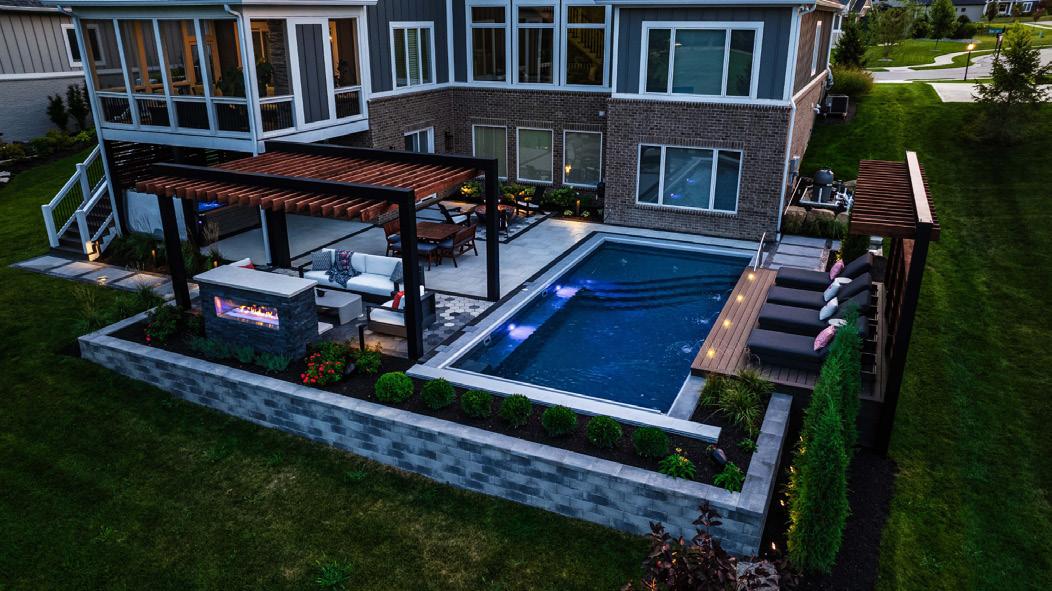
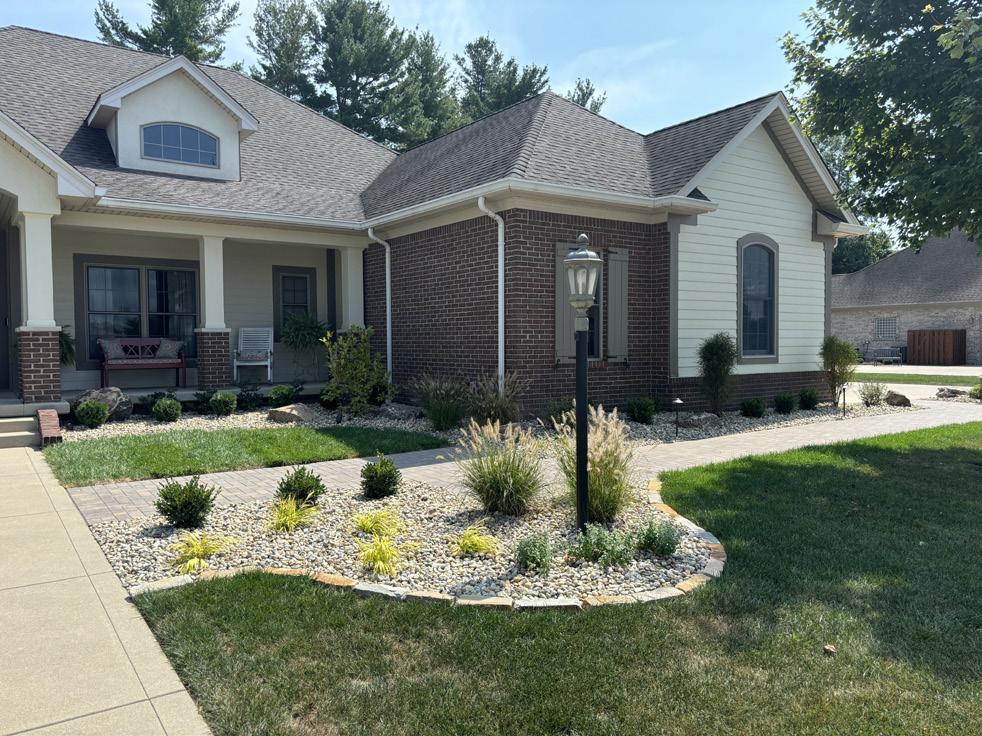


Residential Landscape Under 50KCalvin Landscape Commercial Landscape Under 50KSurridge Design + Eagleson Landscape Commercial Landscape Over 50KCalvin Landscape
Residential Hardscape Over 50K - Calvin Landscape Residential Landscape Over 50K - Aching Acres
PURDUE HORTICULTURE AND LANDSCAPE ARCHITECTURE STUDENTS GAIN HANDS-ON EXPERIENCE INSTALLING LIGHTING
IN THE JULES JANICK HORTICULTURAL GARDEN
By Kyle Daniel, Nursery and Landscape Specialist, Purdue University
On September 19, 2025 students in Purdue Department of Horticulture and Landscape Architecture’s Landscape Contracting and Maintenance class applied their classroom knowledge in a hands-on project at the Jules Janick Horticultural Garden. The students assisted in the installation of new landscape lighting designed to enhance the garden’s evening ambiance and functionality.
The class collaborated with Karen Sullivan, Head Gardener, Rick Hughes from Automatic Supply and Adam Goers from WAC Lighting, who provided expertise for the lighting system. Rick provided a lecture to the students earlier in the week covering different aspects of landscape lighting. Students learned practical aspects of lowvoltage lighting installation, including wiring, fixture placement, and transformer setup—skills directly applicable to professional landscape construction and maintenance.
Some students encountered a challenge in finding the sleeves under the walkways, but a real-world lesson was learned that unexpected issues can arise on any job site.
This project gave the students a valuable opportunity to connect what we discuss in class to a real-world landscape. They not only learn the technical side of installation but also see how design and functionality come together to improve outdoor spaces.
The new lighting highlights key features of the Jules Janick Horticultural Garden, ensuring it remains an inviting and educational space for visitors even after sunset.
LOOKING TO PURCHASE EXISTING BUSINESS
Landscape, Lawncare, Tree and Shrub Care, or Irrigation Business in Indianapolis or surrounding counties.
Call Jim Calvin, Calvin Landscape 317-247-6316
INLA Job Board at www.inla.org
FREE JOB POSTING for INLA members!
Positions are open to any who wish to respond!
To post an open position at your company, please email info@inla.org and send the job description along with how to apply.
Questions? Contact Rick Haggard, 317-889-2382

foundress queen starts a small nest and it is almost always built in a tree top or on a manmade structure. This species will sometimes abandon the first site if there is not room for expansion. The major difference with this species as compared to the NGH is that it exhibits a hawking behavior where it will pick off honeybee workers as they come and go from the colony. These hornets will then retreat to a perch where they tear off the head, abdomen, legs, and wings and then return to their colony with the thorax of the honeybee, which contains the flight muscles which is fed to their larvae. Once the Honeybee colony is sufficiently weakened, the hornets will mass attack the colony to remove the rest of the brood. Even if the hive is not killed outright, the colony can suffer from a temporary forage paralysis because the honeybees are being picked off at high enough numbers that they are getting insufficient supplies of pollen and nectar to raise new brood. The Asian honeybee has developed the strategy of flying fast and low to avoid the hunting YLH while our European honeybees don’t take any measures to avoid being ambushed. The YLH also feed on a wide variety of insects and can depress insect populations across their entire foraging area. YLH are not as large as the NGH, which can reach almost two inches. Average size tends to be between 1-1.5 inches long. But the yellow legged hornet colony can exceed 5,000 individuals. For comparison an extremely large baldfaced hornet nest or NGH nest would number 400 to 500 individuals.
In August of 2023 a YLH specimen was identified near Savanah Georgia. In the fall of 2023 five nests were found and destroyed. The Georgia department of ag was able to find and destroy 47 nests in
2024. Clemson university was also able to find and destroy an additional 16 nests in Beaufort county SC which is adjacent to but across the state line from the Georgia finds. At this point it is too early to tell if this pest will be eradicated but hopefully it is still possible.
If you think you have found any non-native hornet or other invasive species, please notify the Indiana Department of Natural Resources Division of Entomology at 866-NO-EXOTIC [866-6639684] Or E-mail: depp@dnr. IN.gov
Jared Spokowsky is the Apiary Supervisor with the Indiana Department of Natural Resources. When he’s not assisting the beekeepers in Indiana with their hives, he’s helping his own brood in Southeast Indiana keep bees and goats.










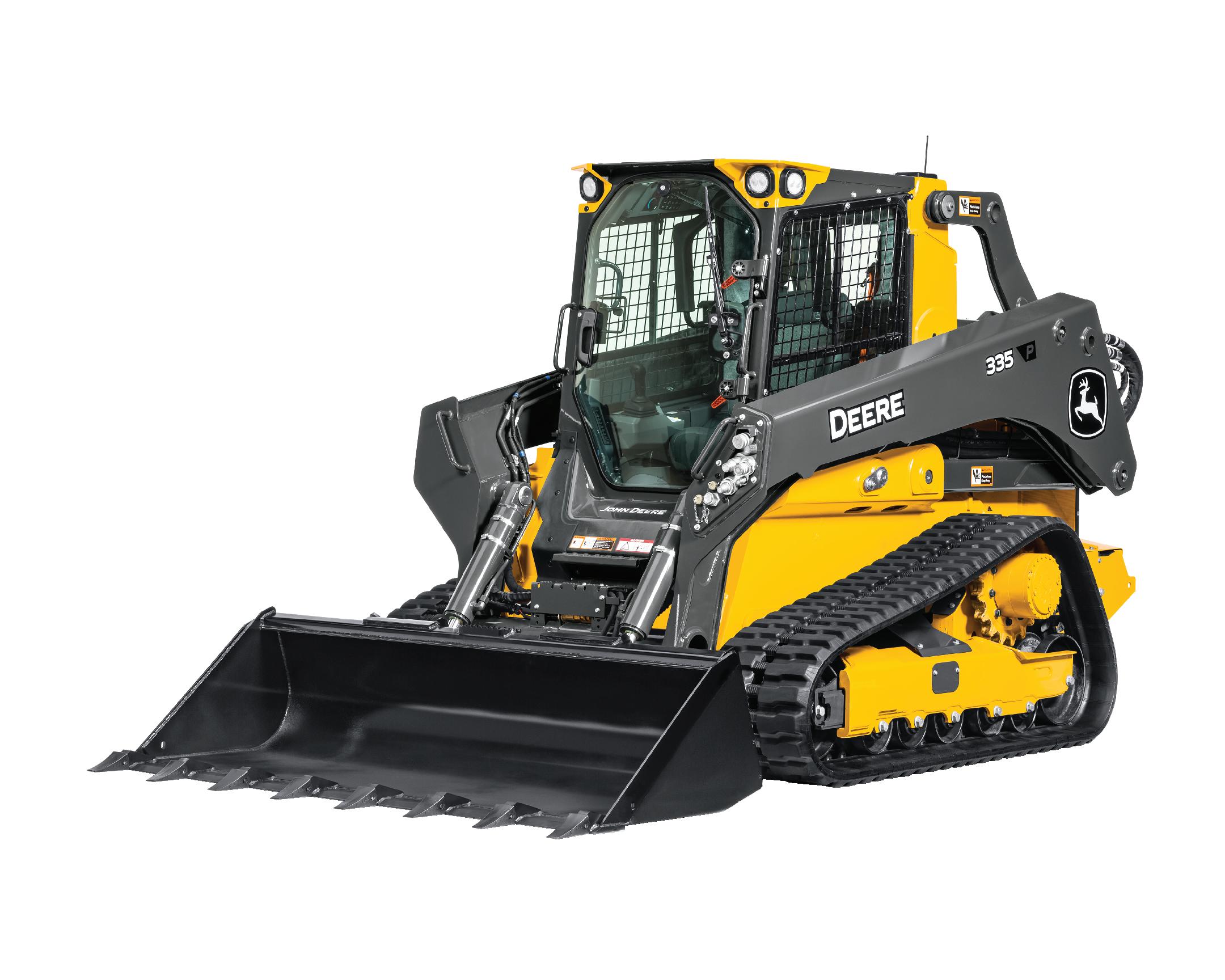
INLA Member Resource - Indiana Department of Natural Resources
Rick Haggard – INLA Executive Director
Dear INLA Members and interested employees. I am attaching a summary below of a recent IDNR, email alert that I personally feel every company, site managers, applicators, etc., should start receiving updates from the Indiana Department of Natural Resources. Please feel free to read this excerpt from October 8, weekly update posted by Megan Abraham. I have used theses for many years and still receive them on a regular basis.
As many of you are aware, customers and the general public often get alarmed by different insects, disease, pests that may appear on a general platform. Please consider getting ahead of the game, utilizing this email resource provided by the IDNR in email updates. I would personally recommend you share this with others in the field of operations to make them more aware of this complimentary resource of information. The site for current and past articles to access is:
https://www.in.gov/dnr/entomology/
Megan Abraham (Division Director & State Entomologist) - MAbraham@dnr.IN.gov
Once in a while a story hits the media that stirs some public concern. Kissing bugs and Chagas disease has made the news cycle lately and has stirred up some public concern. In short, per health experts, the risk to Hoosiers is extraordinarily low.
For more information, here is a brief from Lee Green, senior medical entomologist, Infectious Disease Epidemiology and Prevention Division, Indiana Department of Health.
Chagas disease is caused by a parasite, Trypanosoma cruzi (T. cruzi) that is transmitted by a group of insects called triatomine bugs or “kissing bugs” (fig. 1). There are many bugs that look like triatomines (fig. 2-5) and can bite but are not vectors for the parasite that causes Chagas disease. Unlike many other vectors, this parasite is not transmitted directly through the insect’s bite but through their feces. The parasite is found in the feces of an infected triatomine, and transmission occurs when triatomine feces contaminate a break in the skin (e.g., a bite) or mucous membrane. One kissing bug species, Triatoma sanguisuga, has been found in Indiana, but it is not considered an important vector in transmission. This is because of their delayed defecation behavior, typically moving away from the host before they defecate, which reduces the chances of feces being rubbed into a bite wound. In addition, the standard of housing construction in Indiana acts as a barrier to this bug entering and infesting a home. Therefore, risk is considered extremely low in Indiana. There has not been a confirmed case of locally acquired Chagas disease in Indiana, and there have been low numbers documented in the United States. For questions or requests for arthropod identification, please contact your district medical entomologist. For questions regarding diagnostic considerations, healthcare providers can contact CDC’s Parasitic Diseases Inquiries line at 404-718-4745 or email questions to chagas@cdc.gov.
INLA – Indiana Accredited Horticulturist (IAH) Update
Rick Haggard
The INLA is proud and honored to give its members an update regarding the current status of the IAH Program. The manual has/is going under a major overhaul with much needed updated practices and information. Another caveat to the new manual is it will also become available in a “Spanish” version. While the exact timeline has not been yet set in stone with a full release date, the INLA cannot thank enough the various individual companies that have offered monetary assistance to get this project completed. The INLA has budgeted for this not only this fiscal year but also realized this will involve some training to educators of the program, much like George Brenn did with “Study Guides” for the original IAP as well the current IAH.
The Indiana Nursery Endowment Fund (INLA Scholarship) has donated $4000.00 to keep the ball rolling with the progression and oversight by Dr. Cliff Sadof, who has personally accepted the challenge as a much-needed certification to keep our industry continue as a professional entity. This optional Spanish version will only make individual companies and their employees a tool to be utilized with their own training to hopefully retain much needed production employees. These hopefully will with the advanced opportunity to learn more about the professionalism in our industry and garner the same status as other IAH’ers of the Indiana Nursery and Landscape Association. Our current IAH Program is the only horticulture certification program approve by Indiana Department of Education (DOE) and Department of Workforce Development (DWD) other than a college degree.
I would like further update that since the inception of the original 9-chapter (3” or 4” ringed binder) named Indiana Accredited Plantsman (IAP), which evolved into the current Indiana Accredited Horticulturist (IAH). The binder itself was to be purchased separately (supposedly) as each manual was numbered individually for each person to take the IAP exam and that would be your certificate number. That was quickly altered as most companies that wanted employees to become IAP Certified, purchase one manual and either share by having employees meet one hour after work or let them sign it out for weekend/night! Look how far we have come with offering the study material at no charge and only paying before taking the exam.
As of October 11, 2025, there have been a total of 2,545 individuals, either current/retired Master Indiana Accredited Horticulturist or regular Indiana Accredited Horticulturist paid submissions from the inception of the program in 1974. As I am writing this, I know for years many companies paid for the employees to take the certification exam, in part to show how much value the employee was to the company. I have a personal feeling on why very few employees realized this was the employer’s way of value ranking a certain group of employees were or realized how prestigious this certification garnered respect of others in the green industry field.
I am in hopes that current INLA Member companies continue to utilize this program as a way of rewarding key employees to be recognized as a “valued employee”. I am sure if the employee truly understood the IAH Certificate” value more would definitely wish they had it!
GEORGE BRENN'S IAH STUDY GUIDE

The Indiana Nursery and Landscape Association has developed the Indiana Accredited Horticulturist Program to provide a method of self-study and accreditation for individuals in the nursery industry. The goal of this certification and accreditation program is to develop knowledgeable, motivated, professional employees for the landscape nursery industry.
There are over 700 Indiana Accredited Horticulturists and over 125 Master Horticulturists. The success of the program and the upgrading of the personnel in the nursery industry are direct results of the emphasis the Indiana Nursery and Landscape Association have placed on education programs. You are encouraged to take advantage of this valued educational service of your association.

George Brenn’s IAH Study Guide
George Brenn, MIAH, IAH Committee Chair and Editor, created this study guide to help teach the material covered in the IAH Manual. His intention was to assist those trying to master the subjects within the manual.
Text: © George Brenn
CHAPTER 2 Study Guide
Chapter 2 – Plant Names and Recognition
Plant Names – Is it a tree, a shrub, a vine, a bush, an evergreen, an annual, a perennial……?
Carolus Linnaeus, in 1783, authored Species Plantarum in which he developed the Linnaean Binomial System of Nomenclature (Latin binomial = generic name + specific epithet)
Epithet = a word or phrase applied to a person or thing to describe an actual or attributed quality.
Latin binomial is established for each plant according to the ICBN (International Code of Botanical Nomenclature, as coordinated by the IAPT, International Association for Plant Taxonomy)
Genus species OR Genus species = worldwide recognition of a plant name
Carpinus caroliniana = American Hornbeam, Blue Beech, Ironwood, Musclewood
A name often follows the Latin binomial and is the abbreviation for the person who first named the plant:
Acer saccharum Marsh. identifies Humphrey Marshall as the 1st namer; L. signifies Linnaeus
Accepted Taxonomic Units:
Kingdom, Division, Class & Order have little significance in normal, everyday horticulture.
Cultivar
Family = a group of related genera (genera = plural of genus); name always ends in “aceae” (Rosaceae)
Genus = group of plants containing 1 or more species
Species = group of individual plants, potentially the same, but with distinct morphological differences
(continued on page 24)
GEORGE BRENN'S IAH STUDY GUIDE (CONT.)
People are all different, but we are all Homo sapiens; abbreviated sp. (plural = spp.)
Variety = population within a species displaying marked differences in nature & will reproduce true-to-type
Forma = sporadic variation occurring randomly throughout the population of a species Ilex opaca forma xanthocarpa
Cultivar = cultivated variety: most important unit of horticultural classification:
Cultivar name is not italicized or underlined and has single quotes on either side of cv. Name Acer rubrum ‘Red Sunset’ Viburnum xburkwoodii ‘Mohawk’
Interspecific Hybrids: genetic cross between 2 species: Abelia xgrandiflora = A. chinensis X A. uniflora
Plant Patents = for 20 years after date of plant patent, only patent holder may raise or sell patented plant
Trademarks = Plant names can be trademarked & that name can’ be used as name for any similar plant
Plant Recognition What is that tree, what is that shrub, what is that vine, what is that evergreen……???
Basic plant identification characteristics include:
Leaf Arrangement – Alternate, Opposite
Leaf Form
Simple: entire, lobed, toothed
Compound: palmate, pinnate, bipinnate
Awl like, Needle like, Scale like
Leaf Shape – many options
Leaf Apices (tips)
Leaf Bases
Leaf Margins
Crenate
Dentate
Serrulate Incised etc.
Bud ArrangementTerminal Bud Bud Scales Lateral Bud Leaf Scar Lenticels
Flower Structure –Catkin Corymb Panicle Raceme Spike etc.
(continued on page 25)
GEORGE BRENN'S IAH QUIZ & NEW IAHs
IAH Quiz
Quiz Due December 31
1. In the name Hydrangea paniculata ‘Limelight’, ___________ is the species name.
2. Leaves that possess multiple ____________ are said to be compound.
3. The ___________ nomenclature we use today was developed by Carolus Linneaus.
4. A Plant Key is a reference that would aid in the _________ of an unknown plant.
5. The needles of a Spruce tree are actually its ___________
6. While common names for plants may be different from one region to another, the _________ and ________ names are universal.
Name:
IAH No.:
Phone:
Email:
Send answers to: info@inla.org -or- mail to INLA, 7915 S. Emerson Ave., #247, Indianapolis, IN 46237

Each quiz will be worth a .5 (one-half) CEU!
The Indiana Accredited Horticulturist Committee is pleased to provide you an opportunity to earn CEUs (continuing education units) in each issue of the Indiana Nursery and Landscape News.
The IAH quiz offered in each issue can be completed by anyone who is an “Active” (current) IAH (initial or masters).
Each quiz will be worth a .5 (one-half) CEU (continuing education unit) for the completion of the bi-monthly quiz with a pass rate of 80%. Over a 2-year period, you could earn up to 6 CEUs if you take and pass every quiz!
The INLA office will grade the quiz. Questions and answers have been provided by the IAH committee.
Thank you and good luck studying!
The Indiana Accredited Horticulturist Committee Co-Chairs
- George Brenn, Retired
- Gabriel Gluesenkamp, Designscape Hort Services Committee Members
- Brian Bunge, Twixwood Nursery
- Wayne Gruber, Niemeyer’s Landscape Supply
- Jim Messmer
- Melissa Mravec, Allen Landscape
- Jodie Overmyer, Marshall County Soil and Water




Blue
www.bluegrassfarms.net
Bowling
Brehob Nurseries, LLC................................ outside back
Elevate
Rick Haggard, INLA Executive Director
Indiana Nursery and Landscape Association
7915 S. Emerson Ave., Suite 247
Indianapolis, IN 46237
NOVEMBER | DECEMBER 2025
Address Service Requested

